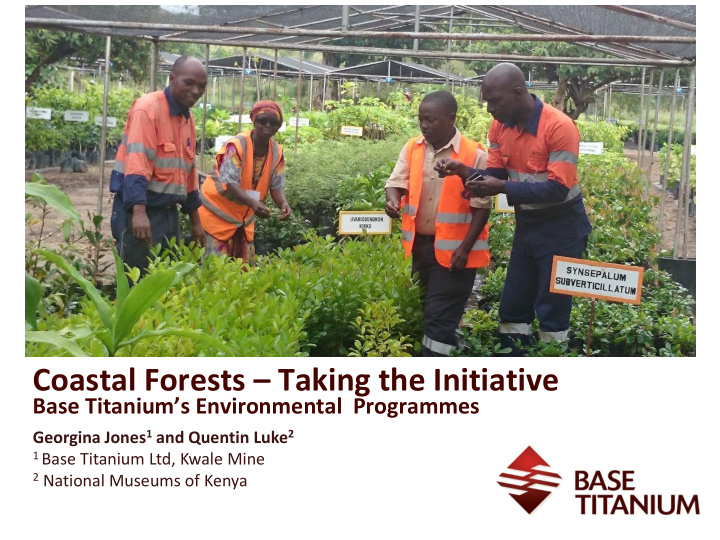



Coastal Forests – Taking the Initiative Base Titanium’s Environmental Programmes Georgina Jones 1 and Quentin Luke 2 1 Base Titanium Ltd, Kwale Mine 2 National Museums of Kenya
Base Titanium’s Kwale Mine Project Overview ♦ Located within Kwale County, 50km south of Mombasa and about 8km inland. ♦ Target minerals include: ♦ Ilmenite (titanium-iron oxide) – raw material for pigment and paint. ♦ Rutile (titanium oxide) – raw material for titanium sponge, titanium metal and pigment. ♦ Zircon (zirconium silicate) – raw material used in refractory and ceramic industries. ♦ Products exported from Base’s shiploading facility in Likoni (bulk ilmenite and rutile) and container facilities in Mombasa (containerised zircon). ♦ Comprehensive environmental policy, management plans and programmes in place and being implemented. ♦ Restoration and rehabilitation is an integral component of Base’s operations.
Base Titanium’s Environmental Programmes Biodiversity and Conservation Programme ♦ Established to exploit opportunities for improving conservation. ♦ Improving our understanding of the regions rich biodiversity. Rare and Threatened Flora Propagation Research Programme ♦ Targeting species of conservation interest. ♦ Identifying suitable species and techniques for use in restoration and rehabilitation. ♦ Establishment of a Restoration Programme Indigenous Tree Nursery.
Base Titanium’s Environmental Programmes Establishing a Biodiversity Corridor ♦ Part of our commitment to achieving a net positive biodiversity and maintaining ecosystem services. ♦ Work commenced in December 2013. ♦ Bridges several remnant patches of indigenous forest within the mine lease to the Gongoni Forest. Re-establishing and Restoring Wetlands ♦ Re-established a wetland which had been dry for many years prior to the commencement of operations. ♦ Now providing a habitat for both flora and faunal species of conservation importance. ♦ Collaboration with specialists from the National Museums of Kenya.
Base Titanium’s Environmental Programmes Waste Recycling Programme ♦ Founded on the principal of Reduce-Reuse- Recycle. ♦ Aims to create a culture of reducing waste, reusing resources and recycling in our organisation and neighbouring communities. Environmental Education Programme ♦ Encouraging everyone to take responsibility for the environment. ♦ In collaboration with our host communities, partner organisations, conservation groups and environmental experts. ♦ Delivery of messages and creating awareness on the importance of protecting the environment, pollution prevention, protecting and conserving biodiversity and environmentally responsible development.
Rare and Threatened Flora Propagation Research Programme Indigenous Tree Nursery ♦ Nursery also functions as a training and educational facility for local community projects and visitors. ♦ All species in nursery are identified by their botanical names. ♦ IUCN Red List of Threatened Species classification recognised.
Coastal Forests of Eastern Africa Biodiversity Hotspot Number 7,252 Kenya Total Number of Species 3,650 Coastal Kenya 670 Total Tree Taxa Coastal Kenya 83 Coastal Kenya 71 Threatened Species Kwale 60 Base Titanium Nursery Base Titanium Indigenous Tree Nursery Target Actual 3 3 Critical (CR) IUCN Threatened Endangered (EN) 29 22 Species 56 35 Vulnerable (VU)
Biodiversity and Conservation Programme Objective ♦ Exploits opportunities for improving conservation outcomes provided by Kwale Mine. Some of our Successes ♦ Euphorbia tanaensis ♦ Gigasiphon macrosiphon
Restoration Programme Indigenous Tree Nursery April – June 2015 To Date Species IUCN Red List Status In Planted In Stock Planted Total 134 187 544 419 963 Critically Endangered Species of Conservation Endangered 1,947 580 3,693 1,374 5,067 Significance (IUCN Threatened Species) 1,049 380 4,431 429 4,860 Vulnerable Potential IUCN 314 64 1,408 435 1,843 Yet to be classified Threatened Species Other Species (IUCN 3,764 9,198 14,600 16,412 31,012 Various Lower Risk Species) 7,208 10,409 24,676 19,069 43,745 Total All Species Various Number of species currently in stock = 208
Restoration and Rehabilitation Phase 1 Rehabilitation and Restoration Activities ♦ Comprises activities ahead of rehabilitation of mined areas. ♦ Includes establishment of a biodiversity corridor. ♦ Incorporates re-established wetland.
Restoration and Rehabilitation Phase 2 Rehabilitation and Restoration Activities ♦ Expansion of Biodiversity Corridor to incorporate areas around the Mukurumudzi Dam. ♦ Rehabilitation and land-use suitability trials. ♦ Initial activities to commence in late 2015. Phase 3 Rehabilitation and Restoration Activities ♦ Preparation of mined Central Dune for rehabilitation. ♦ Rehabilitation of the Central Dune, incorporating backfilling of mining void, laying of topsoil, contouring of land and planting of primary and end-use vegetation. ♦ Planned to commence 2018. Phase 4 Rehabilitation and Restoration Activities ♦ Preparation of mined South Dune for rehabilitation. ♦ Rehabilitation of South Dune. Phase 5 Rehabilitation and Restoration Activities ♦ Preparation of TSF for rehabilitation. ♦ Rehabilitation of TSF. ♦ Closure and rehabilitation of infrastructure sites.
Indigenous Tree Nursery Establishment Costs Restoration Programme Indigenous Tree Nursery Establishment Costs ♦ Nursery established in December 2012. ♦ Opportunities utilised: ♦ Specialist and regional knowledge available amongst Base’s environmental specialists. ♦ Utilises land available within the mine lease. ♦ Mine lease land predominantly previously smallholder farmland with cashew, mango and coconut crops. ♦ Earth moving equipment on site utilised to prepare land. ♦ Ready supply of topsoil from stockpiled stocks. ♦ Use of indigenous tree species. ♦ Remnant forest patches within mine lease protected and used as a seed source. ♦ Rescuing of important species ahead of land clearing. Direct Cost Estimates (USD) Direct Costs FY2012/2013 Infrastructure 20,000 Consumables 5,000 Soil conditioning material 500
Indigenous Tree Nursery Operating Costs Restoration Programme Indigenous Tree Nursery Operating Costs ♦ Workforce – recruited from surrounding communities, necessary skills and training provided by Base environmental specialists and collaborating organisations. ♦ Opportunities utilised: ♦ Partnerships with NMK, KWS, KFS, Kaya elders and community forest associations. ♦ iCIPE collaboration – testing of organic pesticides. ♦ Collection of seed material from protected remnant forest patches on mine site. ♦ Cost saving initiatives: ♦ Minimal soil conditioning material costs, purchase only manure and coir dust from local suppliers, prepare own compost and utilise stockpile topsoil. ♦ Recycling and re-use of consumables eg seedling bags. ♦ No fertilizers or chemical pesticides utilised in nursery. Direct Cost Estimates (USD) Direct Costs FY2013/2014 FY2014/2015 25,000 10,000 Infrastructure Consumables 15,000 5,000 Soil conditioning material 1,500 1,500
basetitanium.com 14
Recommend
More recommend